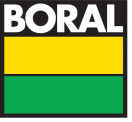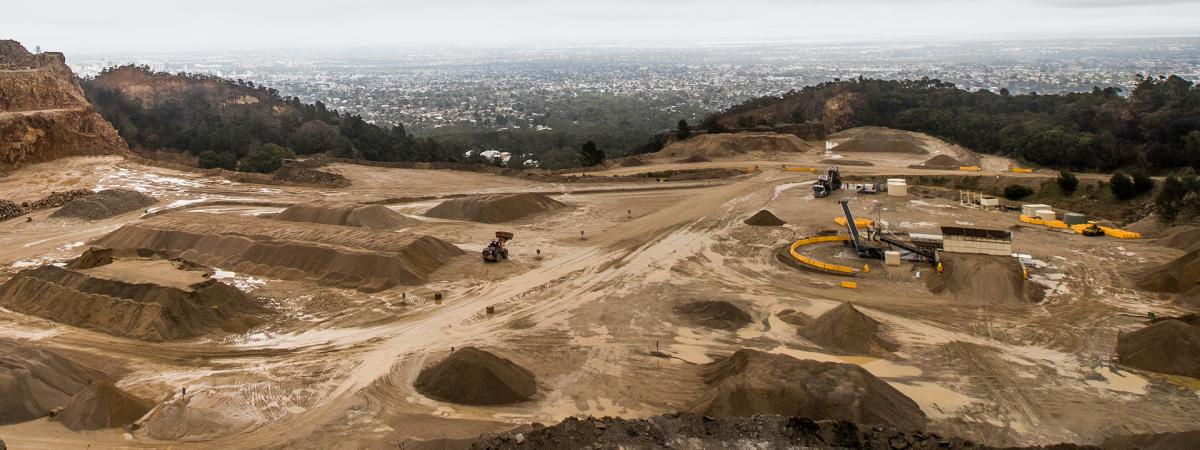The Stonyfell Quarry is one of Adelaide’s oldest quarries, having been in operation since 1837.
Establishing the date of the opening of the Stonyfell Quarry is no easy task. The Record of Mines summary card from the Department of Mines states that it was opened in 1837 by James Edlin to supply slate and building stone. This would have been on a portion of the land now known as Stonyfell Quarry as various sections of land were used for different purposes over the years. These enterprises began independently and ad hoc, and often went undocumented. There are also several conflicting definitions of the area of Stonyfell Quarry, when differing names and dates surface.
In 1858, Henry Clark purchased a section of what is now part of the Boral quarry. He and his fiancé Annie Martin named the property Stonyfell, after the slopes in England called 'fells'.
In 1880 the quarry was worked by hand-mining methods. Secondary breaking of the stone was also done by hand with spalling hammers. In 1881, Henry Dunstan, who by that time owned the quarry, installed a steam-driven Hope Stone Breaker, and for the first time steam was used in South Australia for crushing stone. This would have gone some way to help meet local demand for metal screenings - aggregate used as a base in tar paving (for council footpaths), roads and concreting. The establishment of the Dunstan Tar Paving and Road Metal Depot at Kensington Park was equally innovative and timely, being ideally placed for servicing the roads of Adelaide, particularly the eastern suburbs.
It was envisaged that the Hope Stone Breaker would relieve some of the burden of breaking all the stone by hand. However, it did not relieve the men's workload. Production increased with the aid of the crusher, but no one escaped the noise, the continuous knapping (breaking up) of the larger stones, the loading by hand or the dust, heat and rain.
In 1939, Stonyfell Quarry amalgamated with the other Adelaide Hills quarries to become part of Quarry Industries. The quarry was acquired by Boral when it became the primary shareholder of Quarry Industries Ltd in the 1980s.
The availability of rock in such close proximity to the city of Adelaide helped to make this quarry a major South Australian industry. In the early days of colonisation stone from this quarry played a major part in the construction of buildings and communication networks. Roads were laid down, bridges and culverts constructed and rail tracks laid on beds of ballast. Roads were fundamental in the linking of communities for business and social travel and also for conveying goods and animals to outlying areas.
In present day, resources from the Stonyfell Quarry are used to produce road base, aggregates and washed sands for use in mainly concrete manufacturing.
The material currently extracted from the site consists of sandstone and quartzite. Sandstone is a clastic sedimentary rock composed mainly of sand-sized minerals or rock grains. Sandstone has been used for domestic construction and housewares since prehistoric times, and continues to be used.
Sandstone is one of the most common types of sedimentary rock and is found in sedimentary basins throughout the world. It is often mined for use as a construction material or as a raw material used in manufacturing. In the subsurface, sandstone often serves as an aquifer for groundwater or as a reservoir for oil and natural gas.
Quartzite is a non-foliated metamorphic rock composed almost entirely of quartz. It forms when quartz-rich sandstone is altered by the heat, pressure, and chemical activity of metamorphism. These conditions recrystallize the sand grains and the silica cement that binds them together. The result is a network of interlocking quartz grains of incredible strength.
The interlocking crystalline structure of quartzite makes it a hard, tough, durable rock. Quartzite is very resistant to chemical weathering and often forms ridges and resistant hilltops.
The site comprises diverse rock which enables Boral to produce large tonnages of different materials from the same working area.
These products include road base, aggregates and washed sands for use in mainly concrete manufacturing.
The quarry is situated toward the top of the Second Creek catchment, with runoff discharging directly into the stormwater network, and ultimately into Second Creek via a branch named Ferguson Creek.
The quality of stormwater leaving the quarry is important to us. We have built a number of structures on our site to control and remove sediment, and have commissioned a number of studies to investigate their effectiveness and optimisation.
When it rains, surface water runoff from the hills face and extractive operating areas is directed via roadside drains to a series of nine interconnected detention basins. Stormwater flows are slowed via these basins, which act as a natural filtration system. This allows sand and sediment to drop out of suspension before the water reaches a final series of three vegetated ponds which further filter the water before the water flows off-site over a V-notch weir and into the creek network.
The site also has a variety of erosion controls in place and an ongoing progressive revegetation program, which minimises erosion during heavy rainfall events and aims to improve the visual amenity of the quarry.
The Stonyfell Quarry’s EPA License (Number 1630) identifies Boral’s obligations and requirements toward water quality discharge monitoring at the site.
After changes to the monitoring requirements for Boral’s EPA licence in 2015, a Water Monitoring Plan (WMP) was developed to satisfy the licence’s conditions.
This WMP aligns to the Australian and New Zealand Guidelines for Fresh and Marine Water Quality (ANZECC 2000) which provides guidance for assessing sediment quality.
Although the EPA has approved the WMP and its current implementation at the quarry, storm and high rainfall events such as what we experienced recently are unprecedented. We are implementing measures to ensure levels of sediment run-off are within satisfactory levels to protect our waterways.
The data gathered through the WMP helps to inform management decisions across the business, as well as identify potential opportunities and implement retention strategies to improve water quality.
Whilst the EPA is satisfied with Boral’s current WMP, we are committed to continuously improving our operations.
We continue to progressively implement a range of enhanced stormwater management measures on the site.
As part of our program, we recently engaged an environmental engineering consultant to review the current infrastructure and stormwater management practices.
The completion of this review will result in the identification of further opportunities for improvement at the site.
Our goal is to achieve improved stormwater discharge quality during normal and exceptional rainfall events such as those experienced this year. Boral Stonyfell Quarry has a number of measures in place to manage dust on site.
These measures include:
- The use of a water cart that sprays down roads and stockpiles
- A sprinkler system within the crushing plant
- A truck wash which stops mud and dust dragging out from the quarry onto local roads
- Dust monitoring in various locations
General operating approvals
The Stonyfell Quarry operates as a Private Mine under the SA Mining Act 1971, having begun operations pre-1970. The land upon which Boral quarries has been continuously mined for more than 170 years.
Subdivision of land at Stonyfell Quarry
Stonyfell Quarry is positioned within a 380 hectare Boral-owned landholding between Burnside, Greenhill, Stonyfell, Skye and Horsnell Gully. During the quarry’s history, only a portion of this land has been needed for quarrying activities. This is not expected to change for the foreseeable future.
As Boral has largely the same land management obligations as other local landholders, this ‘excess’ land is generating an additional cost to the business. Further, these lands can potentially present a public liability risk if accessed without permission.
Boral has therefore been working with the relevant State Government authorities to identify appropriate uses for these ‘excess’ parts of the land. These uses have needed to align with the planning goals established for ‘Hills Face Zone’ sites such as Stonyfell Quarry.
One outcome from this work was a proposal which was submitted to the Government’s Development Assessment Commission (DAC) in 2014 for realignment of the title boundaries making up the quarry lands.
This proposal, supported by an appropriate Statement of Effect, was approved by the DAC earlier this year. From the resulting subdivision, Stonyfell Quarry’s landholding will be reduced to approximately 278 hectares, with a 92 hectare parcel dedicated to the state as new conservation land.
The balance has been configured into nine new residential lots which will soon be marketed following the lengthy planning and approval process. Colliers International will be responsible for selling these new residential allotments.
Normal activities will continue at the quarry throughout the transition of the subdivided land to sale.
For any queries relating to the realignment of Boral’s boundaries, phone 02 9033 5215.
Light vehicle entrance
Our new access driveway for ‘light’ vehicles off Heatherbank Terrace became operational during May this year.
Due to the risks arising from light and heavy vehicles interacting at the Stonyfell Road entry, this alternative access point was constructed for light vehicles only.
This access can only be used by cars and utility vehicles, with the exception of Country Fire Service (CFS) vehicles which need access to the hydrants on site.
Trucks will continue to enter and exit via the existing extension of Stonyfell Road.



